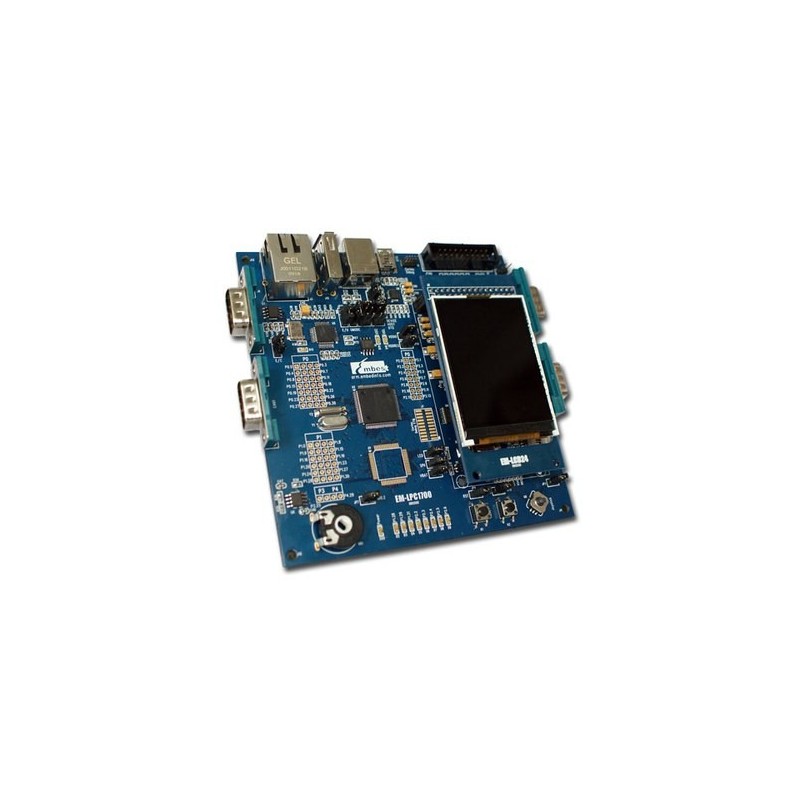- Out-of-Stock

The LPC1768 evaluation board is based on ARM Cortex-M3 processor from NXP, its operating frequency is up to 100MHz, with 512KB high-speed on-Chip Flash Memory and 64KB RAM, together with a colour QVGA LCD, Ethernet, USB, CAN, SD/MMC card interface, and UARTs.
Overview
You can use the Cortex-M3 based LPC1768 ARM Evaluation Board to generate and test application programs for the NXP LPC17xx microcontroller family. The LPC1768 ARM Evaluation Board introduces the new NXP LPC1760 family of ARM Cortex-M3 processor-based devices, allowing you to create and test working programs for this advanced architecture, it has a wide range of interfaces making it a great starting point for your next Cortex-M3 project. With this hands-on process, you can determine the hardware and software requirements for current and future product development.
The LPC1768 ARM Evaluation Board ships with the LPC1768 device that is a superset of several other device variants of the LPC17xx microcontroller series. The LPC1768 Board contains all the hardware components required in a single-chip LPC17xx system.
Hardware Specifications:
The connectors on the LPC1768 arm evaluation board provide easy access to many of the LPC1768's on-chip peripherals.
Block Diagram:

Technical Data
| Parameter | Description |
| Supply Voltage | 5V DC (provided by the USB bus of a PC) |
| Supply Current | 65mA typical, 120mA maximum |
| XTAL Frequency | 12 MHz |
| Microcontroller | NXP LPC1768 |
| Peripherals | 2 × RS232 Interfaces 2 × CAN Interfaces 1 × Ethernet Interface 1 × JTAG Interface 1 × ETM Interface 2 × Cortex Debug Interfaces 1 × LCD Display 1 × USB Device/Host/OTG Interface 1 × Analog Output (connected to speaker by default) 1 × Analog Input (connected to potentiometer by default) |
| Board Size | 119mm x 119mm (4.68 " x 4.68") |
Software and Examples
Embest provides plenty of software examples for this evaluation board, all in source code. These software examples can be debugged under the popular Keil MDK (Microcontroller Development Kit) environments, making practical use of the board's peripherals.
Documentations
There are plenty documentation and material of Embest products, such as user’s manual, schematic of the board, development guideline and most of the major chips’ datasheet, convenient to find them in the accompanied CDROM.
PACKING LIST
| NO | NAME / TYPE | QTY | DESCRIPTION |
| 1 | Embest LPC1768 ARM-CM3 Board | 1 | Main board. |
| 2 | RS-232 Serial Cable / DB9 F-M | 1 | Connect the COM port to Host PC. 9-pin male to 9-pin female, no longer than 10ft/3m, wired one-to-one. |
| 3 | USB Cable / A-B | 1 | To supply power to the board or for downloading and programming. |
| 4 | RJ45 Ethernet Cable | 1 | Connect to the Ethernet port. |
| 5 | TFT LCD Panel | 1 | QVGA(240x320) |
Manufacturer BTC Korporacja sp. z o. o. Lwowska 5 05-120 Legionowo Poland sprzedaz@kamami.pl 22 767 36 20
Responsible person BTC Korporacja sp. z o. o. Lwowska 5 05-120 Legionowo Poland sprzedaz@kamami.pl 22 767 36 20
Module with digital thermal sensor, thermostat and I2C interface
J-LINK EDU Mini is a version of the J-Link EDU (8.08.90) in a reduced form factor with identical functionality for Cortex-M based targets. It has been designed to allow students and educational facilities as well as hobbyists access to top of the line debug probe technology. Version for non-commercial use only. J-Link EDU mini
The DS3231 RTC module for Raspberry Pi is a high-precision, battery-powered, I2C-communicating real-time clock that provides accurate timekeeping thanks to temperature compensation and a quartz resonator
No product available!
No product available!
No product available!
No product available!
ROSA3D filament made of high-quality PLA granules. 3 kg of 1.75 mm filament is wound on the spool. ROSA3D PLA Plus ProSpeed Black
No product available!
MicroHDMI-HDMI cable in black and 1 meter length. It has a gold plated plug.
No product available!
No product available!
No product available!
Development kit with a processor equipped with 8 ARM Cortex-A78AE v8.2 cores and the NVIDIA Ampere graphics system consisting of 1792 cores supporting CUDA technology. NVIDIA 945-13730-0005-000.
No product available!
No product available!
No product available!
No product available!
32-bit microcontroller with ARM Cortex-M4 core, XMC4200 family, 256kB Flash, VQFN-48, Infineon
No product available!
Precision screwdriver set 6 pcs by Velleman
No product available!
No product available!
Universal EEPROM, Flash NAND, SRAM and MCU memory programmer. It is controlled from the computer via the USB interface and software for Windows systems. TL866II Plus
No product available!
No product available!

NXP LPC1768 ARM-CM3 Board
